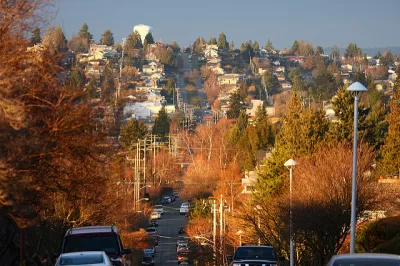"[P]erhaps at this point, this column should include a trigger warning for any young couple traumatized by the current housing market around here."

Gene Balk writes a column about the changes in the Seattle real estate market in terms of what money can buy.
This is not a happy story for many professional, middle-class residents of the city. "It’s hard to believe there was a time, and not really that long ago, when journalists — or teachers, or nurses — could go house hunting in the city of Seattle and actually buy something," writes Balk.
Even adjusting for inflation, the prices of homes in the final decades of the 20th century were far more attainable. For instance, "Census data shows that the median home value in King County in 1980 was $71,400, which, in today’s dollars, is about $225,000. That’s well below half of what it is now," reports Balk.
Balk's presentation of this information is underwritten by the implications of generational conflict. "How much less did boomers pay for their Seattle homes?" asks one of the infographics in the story (and the headline, for that matter).
To even the scales a little, Balk offers a few data points in defense of baby boomers:
…for a lot of folks back then, it didn’t seem so cheap. Keep in mind that King County home values in 1980 were about 50% higher than the U.S. median.
Another mitigating factor: Mortgage interest rates were much higher in the past, particularly in the early 1980s, when they peaked at around 16%. They didn’t fall back down into the single digits until the early 1990s.
There have always been members of the middle class cut out of the homeownership market, according to the implication of that data. Still, Balk expresses sympathy for the many among that number in 2019.
FULL STORY: How much easier was it for baby boomers to buy a home in Seattle? Let’s adjust for inflation

Planetizen Federal Action Tracker
A weekly monitor of how Trump’s orders and actions are impacting planners and planning in America.

Congressman Proposes Bill to Rename DC Metro “Trump Train”
The Make Autorail Great Again Act would withhold federal funding to the system until the Washington Metropolitan Area Transit Authority (WMATA), rebrands as the Washington Metropolitan Authority for Greater Access (WMAGA).

The Simple Legislative Tool Transforming Vacant Downtowns
In California, Michigan and Georgia, an easy win is bringing dollars — and delight — back to city centers.

The States Losing Rural Delivery Rooms at an Alarming Pace
In some states, as few as 9% of rural hospitals still deliver babies. As a result, rising pre-term births, no adequate pre-term care and "harrowing" close calls are a growing reality.

The Small South Asian Republic Going all in on EVs
Thanks to one simple policy change less than five years ago, 65% of new cars in this Himalayan country are now electric.

DC Backpedals on Bike Lane Protection, Swaps Barriers for Paint
Citing aesthetic concerns, the city is removing the concrete barriers and flexposts that once separated Arizona Avenue cyclists from motor vehicles.
Urban Design for Planners 1: Software Tools
This six-course series explores essential urban design concepts using open source software and equips planners with the tools they need to participate fully in the urban design process.
Planning for Universal Design
Learn the tools for implementing Universal Design in planning regulations.
Smith Gee Studio
City of Charlotte
City of Camden Redevelopment Agency
City of Astoria
Transportation Research & Education Center (TREC) at Portland State University
US High Speed Rail Association
City of Camden Redevelopment Agency
Municipality of Princeton (NJ)





























